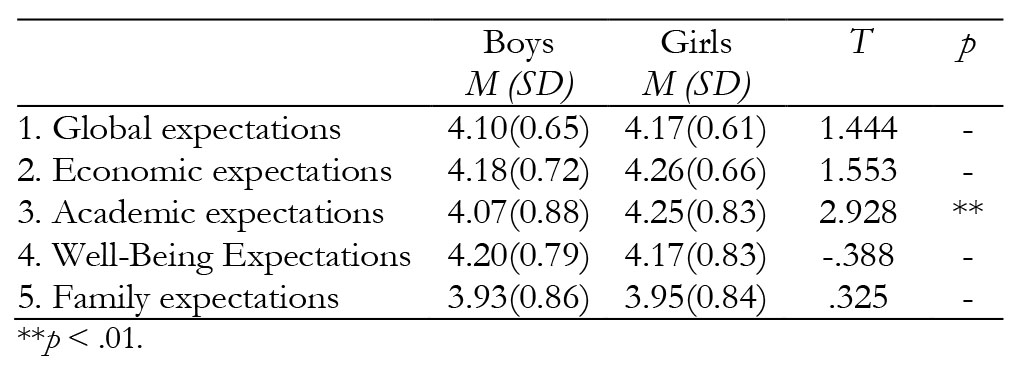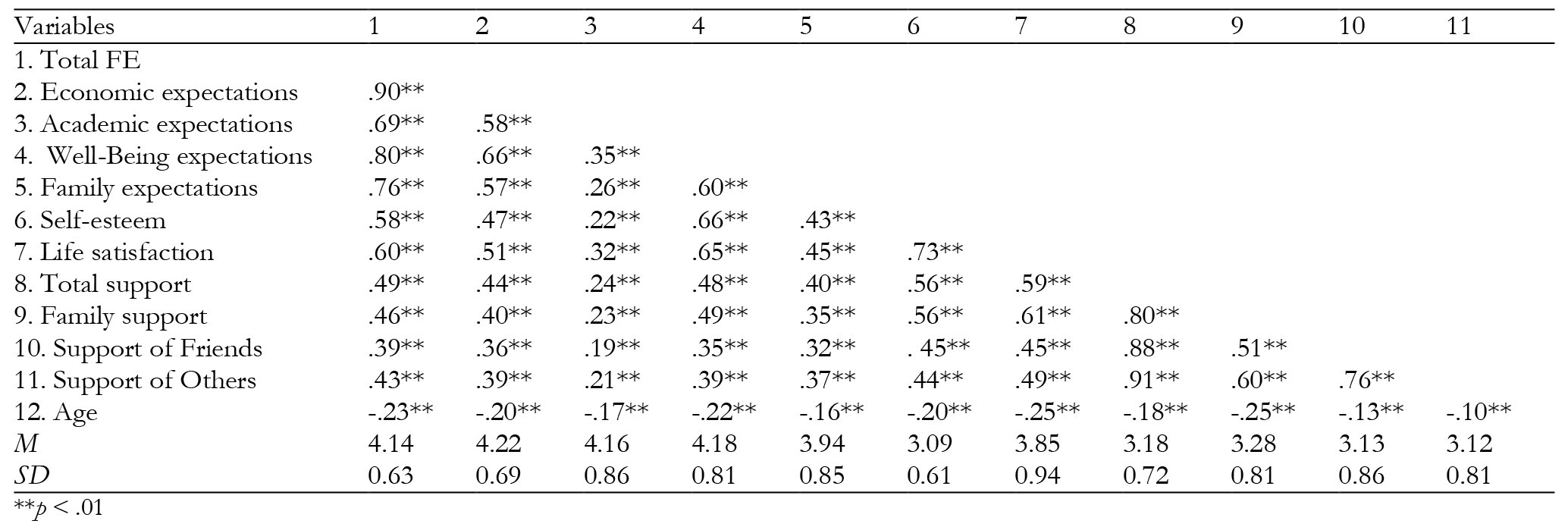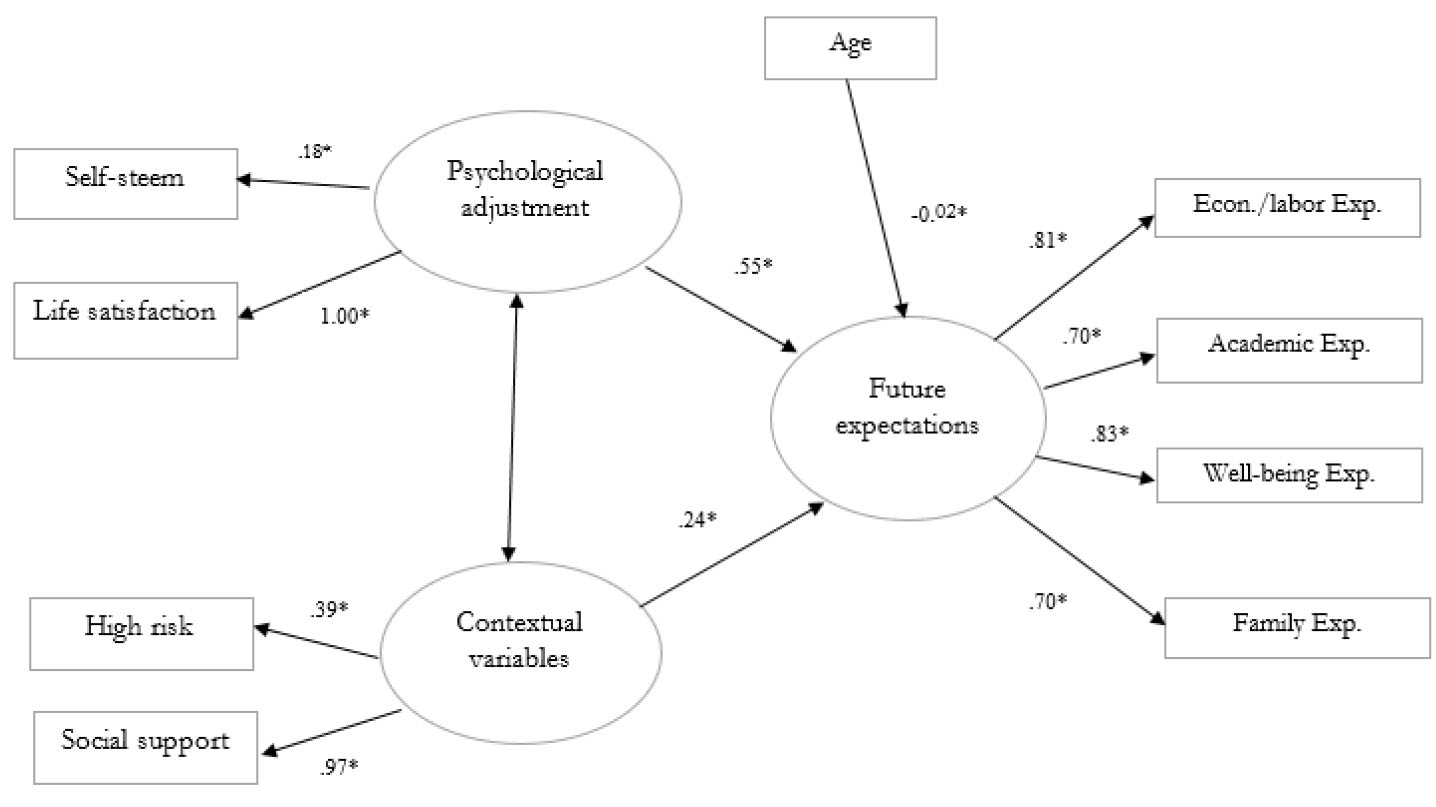Introduction
Future expectations (FE) are defined as beliefs about the probability that an event will occur in the future (Oettingen & Mayer, 2002), influencing the planning and setting of goals, guiding behavior and human development (Bandura, 2001; Nurmi, 1991; Seginer, 2000). Previous studies have shown a relationship between a more favorable current adjustment and having more positive FE. For example, higher performance and motivation (Martín-Romero & Sánchez-Lopez., 2021; Zhao et al., 2019), higher expectations of achievement (Badillo, 2020), as well as a better emotional and social adjustment (Verdugo & Sánchez-Sandoval, 2022) have been associated with higher FE. Having good FE in adolescence can become an indicator of good psychosocial health in adulthood (Kim & Kim, 2020). Conversely, a negative view of the future is related to risky behaviors (Prince et al., 2016; Sipsma et al., 2015) and substance use (Cerqueira et al., 2022). Thinking about the future and building perceptions of oneself in the future act as a source of resilience and motivation (Lawson et al., 2020).
Adolescence and Future Expectations
Although future orientation is an evolutionary task present throughout life, it acquires special relevance during the adolescent stage. The literature places the beginning of the comprehension of the time perspective and concern about the future around the age of 12 (Jiménez, 2011; Oppenheimer, 1987). The decisions one makes then will largely mark one's future life projects (Badillo, 2020). In this period, the "I am" (now) and the "I want to be" (future) converge, guiding human behavior towards desired future goals (Garces-Delgado et al., 2020). Adolescence is conceived as a stage of reflection on future opportunities, desires, and expectations (Lee & Liao, 2021; Seginer, 2008). As they explore future opportunities, make decisions, set goals and achieve them, adolescents are forging their identities, one of the main tasks of adolescence (Branje et al., 2021). In short, FE are essential in adolescent psychosocial development and are considered a positive pathway to adulthood (McDade et al., 2011).
There is little research analyzing the antecedents of the construction of future perceptions. The study and knowledge of these variables could be key to intervening and promoting more positive future life projects (Iovu et al., 2016). Individual and contextual differences related to age, sex, socioeconomic status, and family context interact in the construction of FE (Nurmi, 1991). From an ecological perspective (Bronfenbrenner, 1979), we have identified individual variables, psychological variables, and some contextual variables that could be involved in the construction of FE. Among them, research shows that having a good current psychological and social adjustment could generate adolescents’ more positive FE (Verdugo et al., 2018; Verdugo & Sánchez-Sandoval, 2022).
Individual Variables and Future Expectations
Future orientation is a dynamic and present process throughout life, whose interest in the adolescent stage is underlined (Seginer, 2009). As a result of learning and experiences as they grow older, young people gain a greater understanding of their available interests, resources, and opportunities, which translates into more realistic expectations (Beal & Crockett, 2010). Concerning this topic, Verdugo et al. (2018) analyzed the relationship between FE and age, finding that at older ages, Spanish and Portuguese adolescents obtained lower scores in FE.
On another hand, previous studies show uneven results when analyzing the relationship between FE and sex. At the level of general FE, Brown et al. (2006) stated that boys tend to show more concern about their future than do girls. Conversely, Nurmi (1989) found that boys were more optimistic about their future projects than girls. Regarding the academic area, Luzzo and McWhirter (2001) reported that girls faced greater barriers to their future academic aspirations. Nevertheless, several studies have indicated that girls obtain higher scores in their academic expectations (Agger et al., 2018; Manzano-Sánchez et al., 2021; Mercader et al., 2022; Sharp et al., 2020; Verdugo et al., 2018). As Seginer (2009) pointed out, the disparity between some outcomes could be linked to the sociocultural characteristics of the contexts of the interviewed adolescents. Given the reviewed literature, we intended to provide more empirical evidence, also exploring other future dimensions (economic/labor, personal and family well-being).
Self-Perceptions and Future Expectations
Adolescents' self-assessments influence the process of future orientation (Seginer, 2009). The positive perception of aspects of the self is related to more favorable FE (Iovu et al., 2016), driving goal-oriented behaviors (Verdugo et al., 2018). Numerous studies have found positive and statistically significant relationships between self-esteem and positive FE (Jackman & MacPhee, 2017; Sánchez-Sandoval & Verdugo, 2016; Verdugo et al., 2018; Verdugo & Sánchez-Sandoval, 2022). Self-esteem is considered a predictor of psychological adjustment and social adaptation (Díaz et al., 2018). Other researchers stress that adolescents with low self-esteem are more likely to have more limited ways of coping, greater difficulty coping with adversity, and lower FE (Díaz et al., 2018; Moksnes et al., 2016).
Another self-perception, life satisfaction, has also been highlighted as an important component in building FE. This construct has been defined as a person's global judgment about their life, comparing the desired aspirations with the goals achieved at that time (Pavot et al., 1991). High levels of life satisfaction are associated with a positive attitude towards the attainment of future goals (Herrera et al., 2015). Achieving the desired purposes, in turn, reinforces the feeling of life satisfaction (Castro & Sánchez-López, 2000), influencing adolescents' subjective well-being (Eryilmaz, 2011). Fernández (2018) and Verdugo et al. (2018) evaluated the relationship between life satisfaction and FE in a sample of adolescents, corroborating that, the greater the life satisfaction, the better the FE in the economic, academic, personal, and family well-being areas.
Contextual Variables and Future Expectations
The socioeconomic context in which the adolescent grows up is considered a determinant in the conception of FE (Injuve, 2020; Michael et al., 2017). The characteristics and conditions of the environment in which they develop have an impact on the process of future orientation (Seginer, 2009). The reviewed studies show differences in the construction of adolescents' future perceptions, depending on the socioeconomic characteristics of their development contexts.
Places with indicators of psychosocial risk, such as high levels of poverty, unemployment, crime, and deterioration in housing negatively condition the future opportunities of these young people (Braveman et al., 2011; Zimbardo, 1994). Although adolescence is in itself a vulnerable stage, this is accentuated in individuals living in socially disadvantaged environments (Parrilla et al., 2010). This idea has been supported by studies such as that of Gonçalves et al. (2013), who explored FE in a sample of adolescents from contexts with different levels of psychosocial risk (g1: lived with their families and studied in public schools, g2: lived in foster care, and g3: were complying with socioeducational measures). The results concluded that young people belonging to contexts with a higher level of risk had lower expectations about finishing high school, accessing university, having a decent job, and having a support network. In the same vein, Beal and Crockett (2013) stated that adolescents raised in higher socioeconomic backgrounds reported higher FE than those with a lower socioeconomic status. The opposite results have been reported by other authors. Fernández et al. (2010) concluded in their study that being institutionalized did not imply worse FE. In this regard, Robbins and Bryan (2004) compared FE in high- and low-risk youth, finding no differences in the scores of the two groups. Research on adolescents in situations of social disadvantage indicates that having positive perceptions about the future is a protective factor against risky behaviors (McWhirter & McWhirter, 2008; Seginer, 2009). This study aims to provide more data that will help clarify this controversy.
In this process, the relationship with other microsystems, such as social support systems (family, friends, and others) is crucial (Iovu et al., 2016; Schmidt et al., 2016). It has been shown that adolescents with a high level of participation in their communities develop more positive FE and higher levels of psychological well-being (Jose et al., 2012; Stoddard & Pierce, 2015). Numerous investigations have emphasized the role of family and peer support in the course of learning and building future life projects (Injuve, 2020; Song et al., 2015). Perceptions of greater support are associated with better FE (Fernández et al., 2010). However, perceived lack of family support was also associated with lower expectations for the future (Mercader et al., 2022). In a longitudinal study, students who presented higher FE perceived a higher level of social support at both Times 1 and 2 (Dubow et al., 2001). In a sample of adolescent users and non-users of psychoactive substances, family relationships were identified as a fundamental element in the planning of future goals (Machado & Santos, 2007).
Current Study
This paper aims to deepen the examination of the development of FE during adolescence. Taking into account the review carried out, both personal and contextual variables are incorporated into the same design for their study. In addition, data are provided on boys and girls of a broad age range and from different contexts of psychosocial risk.
The objectives of this study are: a) to analyze the similarities and differences in FE according to age and sex in a sample of adolescents; b) to analyze possible significant relationships between self-perceptions (self-esteem and life satisfaction) and FE; c) to analyze possible significant relationships between contextual variables (level of social risk and perceived social support) and FE; and d) to test a predictive model of FE taking into account personal variables (age, sex, and self-perceptions) and contextual variables (level of risk and social support).
Concerning these objectives, the following hypotheses are tested. (1) FE will differ as a function of age and sex. Expectations are expected to become more negative as age increases. As for sex, girls are expected to have more positive academic expectations. (2) More positive self-perceptions are expected to be associated with higher FE. (3) Higher feelings of perceived social support will be associated with more positive FE. (4) FE of adolescents in higher-risk areas are expected to be lower. (5) Personal and contextual variables are expected to explain the variability of FE. (6) Finally, a positive causal effect of positive self-assessments on adolescents' FE is expected, and a negative effect of living in high-risk areas and receiving fewer supports.
Method
Participants
The sample involved 748 participants, of whom 365 (48.8%) were girls, and 383 (51.2%) were boys. To calculate the sample size, we used the programme G*Power 3.1.9.7 (Faul et al., 2007). They were enrolled in 5th and 6th grade of Primary Education and 1st and 2nd grade of Compulsory Secondary Education (CSE), and aged between 9 and 16 years (M = 11.93, SD = 1.42).
The research design is cross-sectional, following a comparative and predictive associative strategy (Ato et al., 2013). Non-probability convenience sampling was used (Otzen y Monterola, 2017), controlling the variables sex and grade, with similar distributions in the three groups. Participants were selected for being schooled in areas of different levels of social risk. Group 1 (high risk) comes from highly vulnerable areas of the commune of Quilpué (Valparaíso, Chile) (n = 246, 32.9% of the total). Group 2 (medium risk) is enrolled in areas of social transformation ("ERACIS" areas) of the province of Cádiz (n =224, 29.9% of the total). Group 3 (low risk) attends schools located in non-ERACIS areas of Cádiz (n = 278, 37.2% of the total).
All the students in the selected classrooms who had their parents' informed consent to participate in the study and who completed all the questionnaires participated. Questionnaires whose number of missing items accounted for more than 7% of the item in the sample or 5% of the instrument itself were excluded. To impute these data, the regression method and the EM procedure were carried out (all the missing data were random).
The inclusion criteria of the participating schools were as follows:
Group 1. High Risk. Educational centers of the Commune of Quilpué (Chile) with a School Vulnerability Index (IVE) >85%.
Group 2. Medium risk. Educational centers in the province of Cádiz (Spain) located in areas of social transformation (ERACIS Zones) that present the following psychosocial risk indices: urban deterioration, deficit of infrastructure, equipment, and public services, high rates of absenteeism and school failure, high unemployment rates together with serious professional training deficiencies, significant sanitary hygienic deficiencies, and phenomena of social disintegration (Junta de Andalucía, 2018) as well as educational centers classified as compensatory.
Group 3. Low risk. Educational centers in the province of Cádiz (Spain) not included in the areas of social transformation or qualified as compensatory centers.
Preliminary analyses were carried out to confirm a similar distribution in terms of sex and age, in the 3 groups. For this purpose, Chi-square and ANOVA tests were carried out. The analyses showed that there were no significant differences according to sex but there were differences as a function of age. The mean age of Group 1 (high risk) was higher than that of the other groups (Table 1).
Procedure
The project was approved by the Ethics Committee of Biomedical Research of Andalusia (Spain) and the Scientific Ethics Committee of the University of Playa Ancha (CEC UPLA) of Chile. The consent of the regional educational administration, the management of the educational centers, and the parents or guardians of the participants was also obtained.
Initial contact was established with the managers of the schools, presenting the project and requesting their participation in the research. In those schools whose managers agreed to participate, envelopes were delivered with a letter of presentation of the research, the sociodemographic questionnaire for parents/guardians, and informed consent. The children who brought the signed documentation completed the evaluation instruments during class times previously agreed on with the tutors that did not interrupt their academic activity. Two members of the research team were in charge of traveling to the centers and carrying out the evaluations and to resolve possible doubts and incidents during the students' completion of the booklets.
Measures
Scale of Future Expectations in Adolescence (FE;Sánchez-Sandoval & Verdugo, 2016). This evaluates FE through four dimensions (Economic-Labor expectations, Academic expectations, Personal Well-Being expectations, and Family expectations). The scale has 14 items that are scored on a Likert scale ranging from 1 (I'm sure it won't happen) to 5 (I'm sure it will happen). Higher scores indicate more positive FE. The scale has good psychometric properties with an acceptable level of total reliability (α = .87) and of the subscales (Economic expectations, α = .88; Academic expectations, α = .82; Well-Being expectations, α = .80, and Family expectations, α = 68).
Rosenberg's Self-Esteem Scale (RSE; Rosenberg, 1965). We used the Spanish version (Martín-Albo et al., 2007). It includes 10 items that score on a 4-point Likert scale. Higher scores indicate more positive perceptions of one's personal characteristics. In this study, it presented high reliability with a Cronbach's alpha of .86.
Satisfaction with Life Scale (SWLS;Diener et al., 1985; Spanish version by Atienza et al., 2000). This 5-item scale evaluates a person's global judgment of their satisfaction with their life. It is rated on a Likert scale that shows the degree of agreement, ranging from 1 (strongly disagree) to 5 (strongly agree). In this study, it presented high reliability with a Cronbach's alpha of .84.
Multidimensional Scale of Perceived Social Support (MSPSS;Zimet et al., 1988; Spanish version by Ruiz Jiménez et al., 2017). This scale measures a person's felt level of support from their environment. Each of its 12 items is scored on a Likert scale ranging from 1 (strongly disagree) to 7 (strongly agree). This scale had good psychometric properties in our sample (α = .92).
In addition, an ad hoc questionnaire was developed to measure the sociodemographic variables of the sample according to the parents/guardians, and another according to the children.
Data Analysis
Data were coded and analyzed with the SPSS version 21 and FACTOR, EQS 6.1 programs. Through a descriptive analysis, the means, standard deviations, and percentages of the different variables were obtained. Bivariate correlation analyses were performed for the relationships between the studied variables. Chi-square and ANOVA tests were performed to analyze the differences by sex and risk level, respectively. Some regression analysis models were carried out. FE and their subscales were included as dependent variables, and as independent variables of the model: sociodemographic variables (sex and age), psychological variables (self-esteem and life satisfaction), and contextual variables (level of risk and perceived social support). Different models were tested for each dimension of FE. Previously, the assumptions for the application of each statistical test were checked. Finally, a model of structural equations was estimated to study the causal effect of the studied variables.
Results
Future Expectations and Sociodemographic Variables
In relation to sex, significant differences were only found in the dimension of academic expectations (t(746) = 2.92, p < .01), with girls having higher expectations (Table 2). The effect size of these differences was low (d = -0.21). As Table 3 shows, the age of young people correlated negatively and significantly with total FE (r = -.23, p < .01) and with each of the subscales (Economic expectations, r = -.20; Academic expectations, r = -.17; Well-Being expectations, r = -.22; and Family expectations, r = -.16, p < .01). The older they were, the lower were their expectations.
Future Expectations and Psychological Variables
Table 3 shows the correlations between FE (total and subscales) and the studied variables. At a general level, the results revealed positive, moderate, and statistically significant correlations between the studied variables. Concerning self-assessments, global FE showed positive, significant, and moderate correlations with life satisfaction (r = .60, p < .01) and self-esteem (r = .58, p < .01). Higher scores on life satisfaction and self-esteem were related to higher scores on FE. Each dimension of FE showed positive and significant correlations with life satisfaction (Economic expectations, r = .51; Academic expectations, r = .32; Well-Being expectations, r = .65; Family expectations,r = .45) and self-esteem (Economic expectations, r = .47; Academic expectations, r = .22; Well-Being expectations, r = .66; Family expectations, r = .43).
Future Expectations and Contextual Variables
Regarding perceived social support, three positive, significant, and moderate correlations between perceived social support and FE can be observed in Table 3 (r = .49, p < .01). These results were similar when comparing the domains of the two scales. As participants perceived higher levels of social support, they scored higher on FE.
To determine the possible differences in these adolescents' FE according to their level of risk, a one-factor ANOVA was performed with its corresponding post hoc Bonferroni analysis (Table 4). After controlling for age, and as reflected in Table 4, the students from more vulnerable contexts presented lower scores in their FE. The main differences were between Group 1 and Group 3, with significant differences in all the domains. Statistically significant differences were also found between Groups 1 and 2 in most of the domains. Groups 2 and 3 only showed differences in academic expectation.
Predictive Capacity of Individual and Contextual Variables for Future Expectations
Several multiple linear regression analyses were performed. Previously, the multivariate assumptions in each of the subscales were checked. The data showed an absence of collinearity. For this objective, the global scale and each domain of FE were used as dependent variables, and sociodemographic (age and sex), psychological (self-esteem and satisfaction) and contextual variables (social support and risk level) were used as independent variables. The stepwise method was employed. In Table 5, we can see the variables included in each resulting regression model. Sex was not statistically significant so it was excluded from the final models (except for the academic field, where the differences were significant).
Table 5: Summary of the regression analysis of the predictor variables of global future expectations and its subscales.
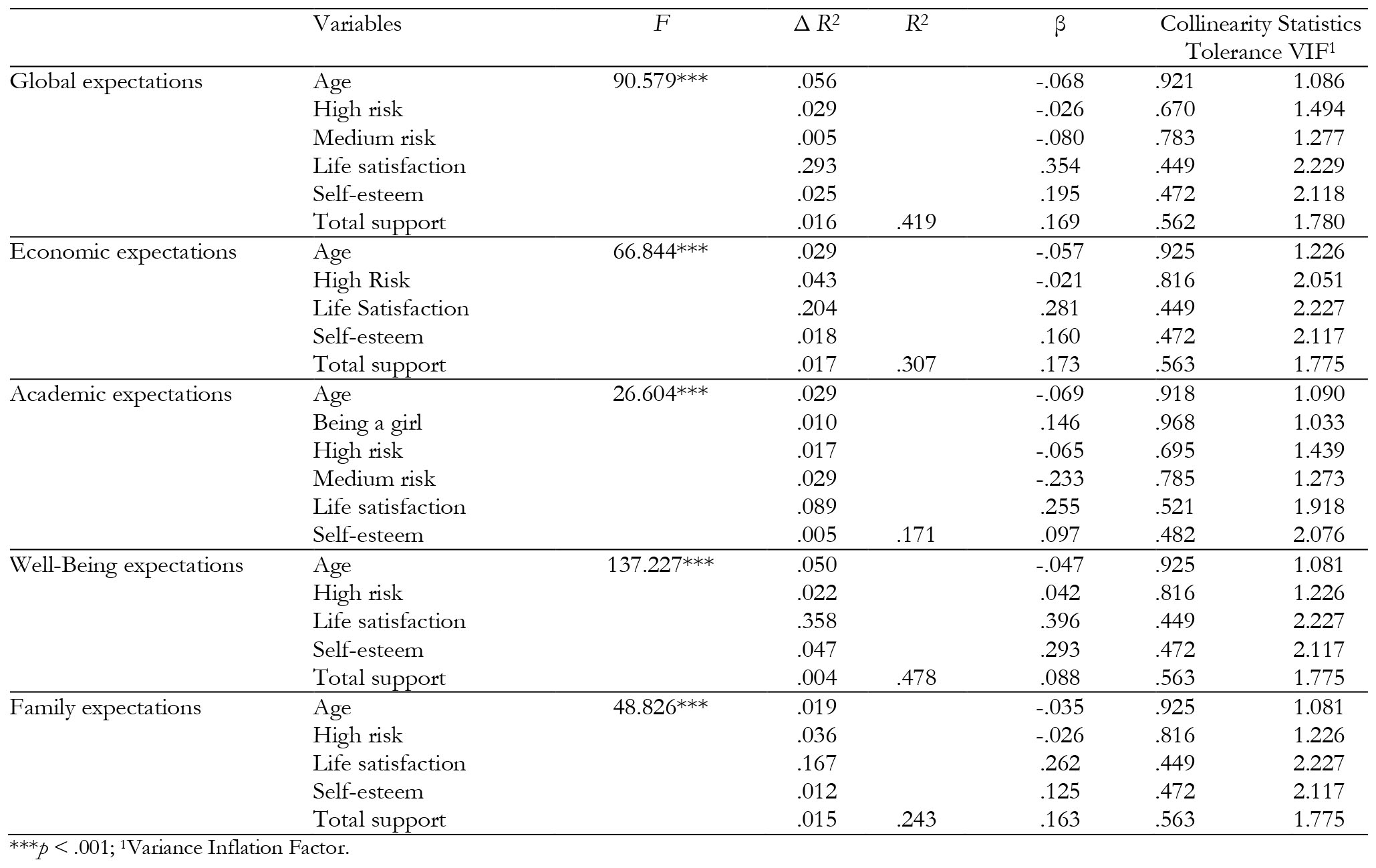
***p < .001;
1Variance Inflation Factor.
The coefficient of determination (R2 ) indicated that the variables age, belonging to a medium or high-risk group and by the levels of life satisfaction, self-esteem, and perceived social support explained 41.9% of the variance of global FE. The magnitude of the effect size of R (R2) was large (Cohen, 1988). The slope of FE decreased as age increased. Expectations became more positive as life satisfaction, self-esteem, and perceived social support increased. According to the Beta values, belonging to the medium or high-risk group lowered the levels of adolescents' FE.
Regarding economic/labor expectations, five variables were included in the prediction model: age, high-risk level, life satisfaction, self-esteem, and perceived social support, which explained 30.7% of the variance. The strength of association was high. Economic/labor expectations decreased as age increased. The slope of the FE also increased with higher levels of life satisfaction, self-esteem, and perceived social support. In addition, according to the Beta scores, belonging to a high-risk context lowered future economic/labor expectations.
The third model, which attempted to predict academic expectations, included six predictor variables (age, being young, high-risk, medium-risk, life satisfaction, and self-esteem), which conjointly explained 17.1% of the variance. The magnitude of the effect size of R (R2) was moderate. Academic expectations decreased as age increased. The higher the levels of life satisfaction and self-esteem, the higher the academic expectations. In addition, according to the Beta values, girls showed higher academic expectations, whereas growing up in more vulnerable contexts implied lower academic expectations.
The fourth model included five predictor variables (age, high-risk, life satisfaction, self-esteem, and perceived social support), which explained 47.8% of personal well-being expectations. The magnitude of the effect size of R (R2) indicated a strong association. These expectations decreased as a function of age, but they increased as adolescents' levels of life satisfaction, self-esteem, and perceived social support were higher. Likewise, according to Beta scores, belonging to a high-risk group was related to lower well-being expectations.
The last model, which attempted to predict family expectations, also included five predictors (age, high-risk, life satisfaction, self-esteem, and perceived social support), which explained 24.3% of the variance. The magnitude of the effect size was moderate. According to the Beta values, the family expectations of these adolescents decreased with age. The slope of family expectations rose as levels of satisfaction, self-esteem, and perceived social support increased. In addition, belonging to the most socially vulnerable group decreased the score of family expectations.
Predictive Model of Future Expectations
Finally, a structural equations analysis was performed to test a model of the influence of personal and contextual variables on FE. As a first step, the normality of the data, the characteristics of skewness and kurtosis, and Mardia's coefficient of multivariate kurtosis were analyzed. The Mardia coefficient obtained exceeded the limit value of 5 established to be considered a multivariate normal distribution (Bentler, 2005). Therefore, the maximum robust likelihood (RML) method was employed. The proposed predictive model consisted of the variables age, psychological adjustment (self-esteem and life satisfaction), and contextual variables (social support and high risk). The results showed an optimal model, which explained 51.7% of the variance of FE. All estimates were statistically significant and the model fit correctly (Table 6). The standardized regression coefficients revealed the influence of the variables included in the model on the dependent variable (Figure 1).
Table 6: Measurement model fit indicators.
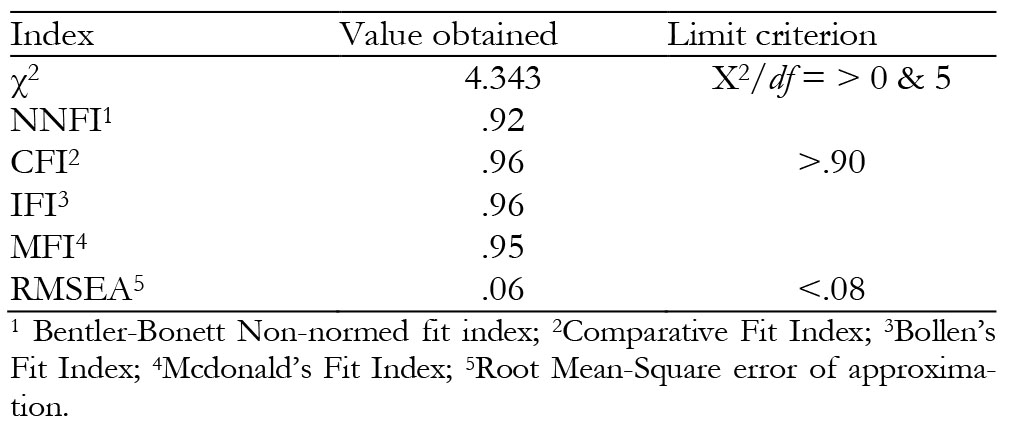
1Bentler-Bonett Non-normed fit index;
2Comparative Fit Index;
3Bollen's Fit Index;
4Mcdonald's Fit Index;
5Root Mean-Square error of approxima-tion.
Discussion
Concerning the importance of having a positive vision of one's future, this work aims to provide empirical evidence of the antecedents of FE during adolescence. It analyzes these expectations in adolescents from three areas with different socioeconomic characteristics. Our findings support FE as a construct to which multiple factors contribute. Following an ecological perspective, individual, psychological, and contextual variables related to FE during this stage have been identified.
Concerning the first hypothesis of this work, this study expanded the age range reviewed in the literature, providing data in boys and girls from 5th grade of Primary School to 2nd grade of CSE. The results show that as they grow older, they present lower expectations, in the same line as other studies such as those of Verdugo et al. (2018). In this sense, Beal and Crockett (2013) emphasize experience as a key factor in the processes of the formation of expectations. As they get older, adolescents project expectations more in line with their resources and possibilities, which become more negative. Regarding sex, there are few differences in the present work. They can only be observed in the academic field, in which girls score higher. The results of this work are in line with those of other authors such as Agger et al. (2018), Manzano-Sánchez et al. (2021), and Verdugo et al. (2018). These data are hopeful because, although girls indeed find more difficulties (Luzzo and McWhirter, 2001), the reality of our data is that they overcome them, building a hopeful image of their academic future.
About the second hypothesis of this study, the existence of positive and significant relationships between self-perceptions and FE is corroborated, as stated by Seginer (2009). In the present study and in line with the literature, it has been found that higher levels of self-esteem and life satisfaction in adolescents are related to higher FE scores (Fernández, 2018; Jackman & MacPhee, 2017; Verdugo et al., 2018; Verdugo & Sánchez-Sandoval, 2022). These results support the findings of Iovu et al. (2016): Adolescents with more positive self-perceptions tend to project more positive futures as well. Other authors show that the achievement of desired goals leads to high feelings of life satisfaction (Castro & Sánchez-López, 2000), in turn, influencing adolescents' subjective well-being (Eryilmaz, 2011).
The third hypothesis of this work positively related perceived social support to FE. The data found in this research coincide with what is generally stated in the literature presented in the introduction; Higher levels of perceived social support are related to more positive future self-representations. These results highlight the support by significant people as a protective factor for the development of positive life projects in adolescence (Injuve, 2020).
Concerning the fourth hypothesis, it would be expected that adolescents who grow up in a context with a higher psychosocial risk index will have lower FE. The existing literature on the subject is not very extensive and also shows some disparity on the subject. In the present analysis, statistically significant differences were found in FE depending on the level of risk, with a notable difference between the high-risk group and the low-risk group. Students from more vulnerable contexts clearly have worse overall FE. Between the low-risk and medium-risk groups, hardly any significant relationships were found. These data support the idea that contexts with greater social and economic disadvantage restrict adolescents' future opportunities (Beal & Crockett, 2013; Braveman et al., 2011). In this sense, Gonçalves et al. (2013) with a methodology similar to that of this work, obtained the same conclusions in the educational, labor, and social fields. These results underscore how the environment in which these children grow up influences the process of future orientation, and identifies the contexts most in need of preventive intervention.
The fifth research hypothesis has to do with the predictive capacity of individual (sex and age), psychological (life satisfaction and self-esteem), and contextual variables (perceived social support and level of risk). Regression analyses indicate that sex does not contribute significantly to predicting FE coinciding with Mercader et al., (2022). The results emphasize the importance of a good psychological adjustment and the need to have support networks at present for the development of more positive future life projects. In addition, they provide data on the role played by the context in which these adolescents grow up. Environments with high rates of psychosocial risk negatively condition the future aspirations of the young people who grow up in them. This shows the need to act in these environments, to promote more positive life plans.
Regarding the last hypothesis, a preliminary model of structural equations on the influence of personal and contextual variables and their explanatory power of these adolescents' FE is proposed. In this sense, the influence of psychological adjustment and the contextual variables on the development of these expectations is confirmed, with the former presenting a higher factorial load, coinciding with other models proposed in Spanish and Portuguese adolescents (Verdugo et al., 2018). As shown in the regression analyses, life satisfaction is the indicator with the highest loading on the psychological adjustment factor. As can be seen, age presents a very weak factor loading, so we proposed to reconsider it for future models. The model explained 51.7% of the variance, so we proposed to continue studying other variables that may contribute to adolescents' FE.
In conclusion, having a positive self-concept, high levels of life satisfaction, and feeling supported by significant others are considered protective factors for the development of positive FE. That is, current adequate psychological and social adjustment motivate behaviors oriented to goal achievement (Verdugo et al., 2018; Verdugo & Sánchez-Sandoval, 2022). Likewise, research on adolescents in situations of social disadvantage indicates that having positive perceptions towards the future is a protective factor against risk behaviors (McWhirter & McWhirter, 2008; Seginer, 2009). On the other hand, these results highlight the role of the environment in the future orientation process, and identify the contexts most in need of preventive intervention.
This work has some limitations. The criteria delimiting the risk areas do not take into account possible intra-group variability. Therefore, concerning future research, it is proposed to build a particular quantitative psychosocial risk index for each family to make more accurate comparisons. Given the pandemic context we are undergoing, it would be interesting to study these adolescents in a few years to see the influence of the pandemic on their FE. In addition, we suggest completing the model with other variables related to FE (resilience, problem-solving strategies, emotional adjustment…). Likewise, having other sources of information such as parents and teachers would allow us to analyze how external perceptions influence FE.
These results can be applied to the design of psychoeducational programs to be used in educational centers with adolescents. Programs of this type, which address the optimization of personal resources and psychological well-being, have been shown to have positive results (Kelley et al., 2021).














